WEDNESDAY
JULY 31 - 2013
BROOK
MEADOW
It was so good to get
back to the meadow after a few days away on the Isle
of Wight. I had a mooch around the orchid area where
Gatekeepers were feeding on the Common
Fleabane. Usually they settled with wings closed, but
this one obliged by opening up its wings for me.
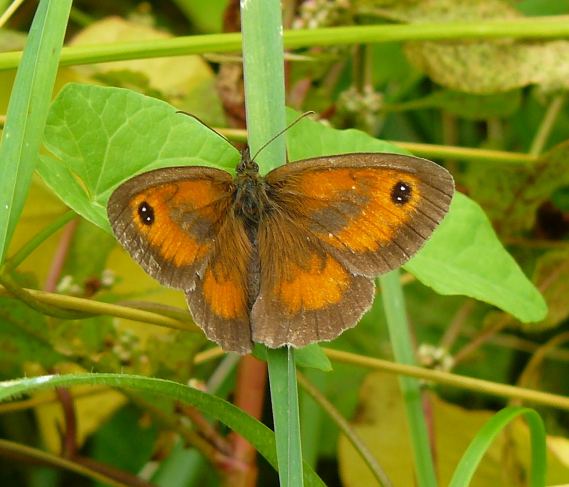
Other plants recently
flowering in the orchid area included Square-stalked
St John's-wort, Hemp Agrimony, and a late Meadow
Buttercup. The seedheads of Great Burnet were still
prominent. The yellow discs of Hoary Ragwort are now
showing and will soon be open. Jointed Rush and False
Fox Sedge were also easy to see among the rampant
growth of grasses and bindweed in this area. The first
of the Wild Angelicas was unfurling its flowers on the
Lumley area. Pepper-saxifrage was in bud, but not yet
in flower.
Red soldier
beetles were on virtually every Hogweed flower
head, 'bonking' in pairs and occasionally in threes
and foursomes!

MILLPOND
NEWS
I had a quick look at
the Hermitage Millponds. The Mute Swan on Peter Pond
still has her one remaining cygnet. It might well be
safe as I could see no sign of any Great Black-backed
Gulls on Slipper Millpond, suggesting they may have
left. I shall need to check again.
OTHER
NEWS
Sparrowhawk
family
Chris Berners-Price
reported a fine sight this morning in Nore Barn Woods.
A pigeon flying through the woods being followed by 3
small Sparrowhawks as the male taught the two
fledglings to hunt - all within 6 feet of each other -
lots of noise!
Warblington
birds
Peter Milinets-Raby
had the following sightings on a walk from Warblington
to Langstone. On the shore were 1 Greenshank, 21
Redshank, 2 Lapwing, 1 Whimbrel, 3 Curlew. A Peregrine
perched on one of the mud banks. A Great Crested Grebe
came in with the tide. Off Langstone Mill Pond was an
adult Med Gull in partial winter plumage, plus an
assortment of young Black-headed Gulls. On Langstone
Mill Pond were 76 eclipse plumaged Mallard, 2 eclipse
plumaged Teal, 30+ Little Egrets viewable, family of
Mute Swans (2 adults with 3 Juvs). 7 plus Swallows
were flying around and two juvenile Buzzards with two
adults off Pook Lane (almost certainly bred here).
Here
is Peter's eclipse plumaged Teal
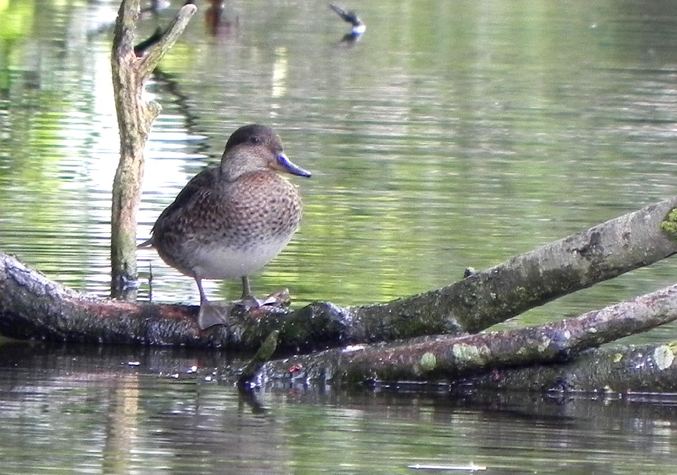
HAYLING
OYSTERBEDS
Chris Cockburn
provided the following news up date on the seabird
breeding from Hayling Oysterbeds:
"Although a complete
hush has not yet descended on the Oysterbeds lagoon,
it is much quieter now that nearly all of the gulls
have left after a welcome highly-productive season.
The noisiest event today was when a 'pair' of very
smart common gulls started displaying on the western
most island (whilst being dive-bombed by many furious
common terns!).
At least twelve
common tern fledglings and their parents have
left the site. Hopefully, there will still be as many
small common tern chicks on the western island
tomorrow as there were today (at least eight more than
were seen on Sunday) and there are still two or three
common terns 'apparently on eggs'. It now seems that
the suspected food problem has ceased and nearly all
of the recent hatchlings (mostly two per nest) are
surviving. However, the big spring tides (and the
associated rising strandline) of last week flooded out
at least seven common tern nests on the easternmost
curved island, which now has very few birds and,
therefore, more likely to be prone to avian predation
(but, fingers crossed.!).
The Mediterranean
gulls have now gone and, interestingly, so have
most of the 40+ Sandwich terns that were roosting with
them during the last fortnight. The few visiting
Sandwich terns are now using both islands, which
suggests that Med gulls are indeed excellent 'decoys'
for Sandwich terns (and vice versa). It has been
suggested (thanks Bob) that Sandwich terns can be
attracted to a site by using a very simple black/white
object (hood/neck contrast similarity?) - perhaps, Med
gulls too could be easily attracted to new sites,
assuming they are wanted there!
The autumn
migration is picking up with increasing numbers of
oystercatchers, black-tailed godwits and curlews in
the harbour area and the appearance at the Oysterbeds
of turnstones, common sandpipers, redshanks etc.
Compared to last year,
when it seemed that spotting any insect was a
major event, insects are becoming increasingly
abundant (even Peacock butterflies appearing on cue as
the Teasels came into flower). Many visitors have
mentioned the apparent (welcome?!) lack of wasps; but
things may well change with the 'fruiting' season
returning to a more traditional time (e.g.
blackberries are unlikely to ripen as early as in
recent years - much to the present disappointment of
those people hoping to make bountiful harvest ).
SATURDAY
JULY 27 - 2013
MALCOLM'S
PHOTOS
Malcolm got a good
variety of photos today. While on Brook Meadow he
captured this excellent image of a Meadow
Grasshopper, showing clearly its short forewing
and absence of hind wing, making it the only
flightless British grasshopper. It is the most common
grasshopper on Brook Meadow.
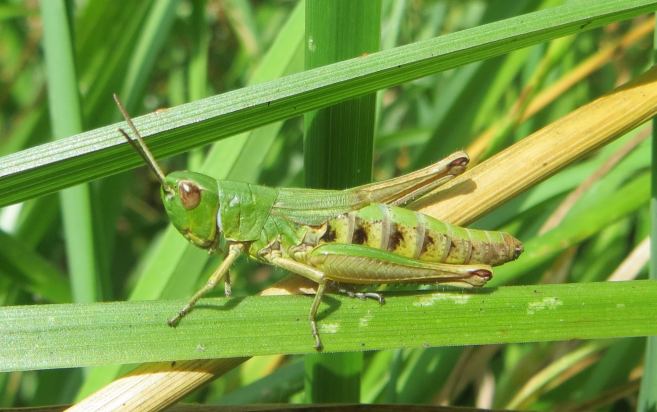
Malcolm took this picture of a juvenile Green
Woodpecker in his brother's garden. He says the
bird had been attacked by something and his brother
was trying to get it up and flying again.
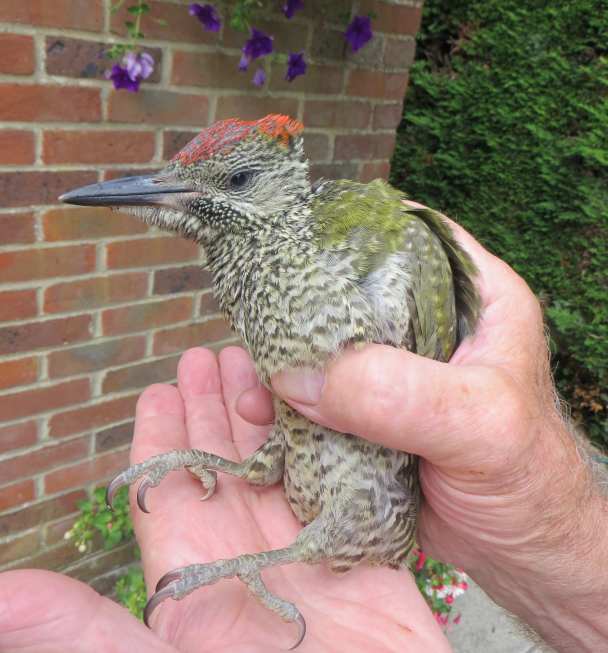
Also, in his brother's
garden Malcolm got this nice photo of a male
Brimstone - the first of this insect's summer
brood. We shall probably continue to see them until
the end of September and even later.
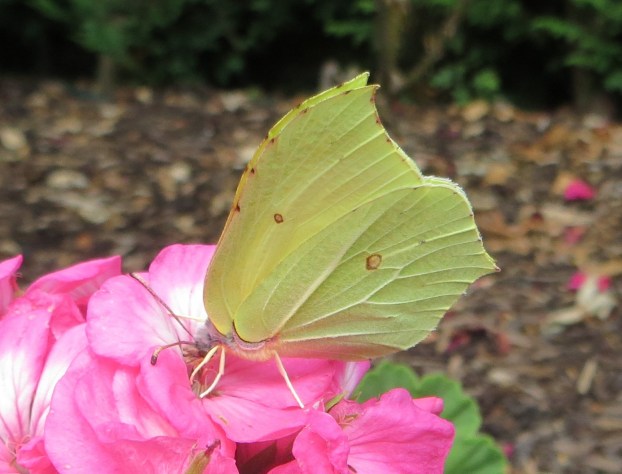
IPING
AND STEDHAM COMMON
Ros Norton reported on
today's walk by the Havant Wildlife Group
"Four of us explored
the above commons on a hot and sunny morning which
brought the butterflies out early. Highlights included
quite a lot of silver-studded blue butterflies around
the heather, 3 silver-washed fritillaries together
nectaring on bramble flowers, and a white admiral
which perched on a white car in the car park. Others
were brimstones, green veined whites, gatekeepers,
meadow browns, speckled woods and large skippers. An
emperor dragonfly flew over a small pond.
Spiderlings moved in webs on gorse bushes.
A common lizard basked in the sun.
Among the birds were a pair of stonechats, several
yellowhammers, linnets, a nuthatch, Treecreeper,
greater spotted woodpecker, swallows, a buzzard and
many tits including coal and long tailed.
Flowers were mostly ling, cross leaved heath and bell
heather but also harebells, rosebay willowherb and
dodder.
FRIDAY
JULY 26 - 2013
BROOK
MEADOW
Water
Vole
Malcolm Phillips went
round the meadow from 9.30am till 11.00am this morning
and , of course, managed to find and photograph a
Water Vole. Here is Malcolm's photo of the vole
peeping from a hole on the north bank of the river
near the railway tunnel at 10.20am.
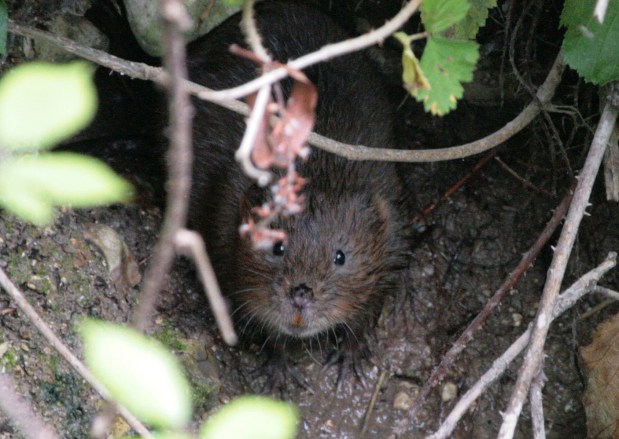
Butterflies
Malcolm also got a
photo of this very fresh Peacock butterfly,
clearly one of the new summer brood which are just
emerging at this time. I also had one in my garden
today.
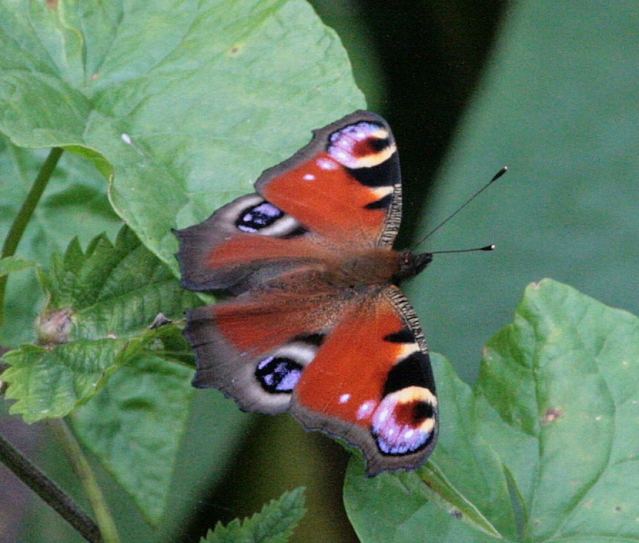
Plants
I discovered just one
plant of Common Ragwort in flower on Brook
Meadow - the first of the year for what is quite a
rare plant on the meadow. I shall not reveal its
whereabouts just in case some misguided person decides
it should be pulled up. Common Ragwort is in fact a
valuable source of nectar and the sole food source for
the larvae of the Cinnabar moth. Mugwort and Stone
Parsley are also in flower more generally.
Turning to the
waysides, Rosebay Willowherb is flowering well
on the small Railway Wayside in front of the large
poster (now showing a heavily tatooed David Beckham
advertising Sky TV).
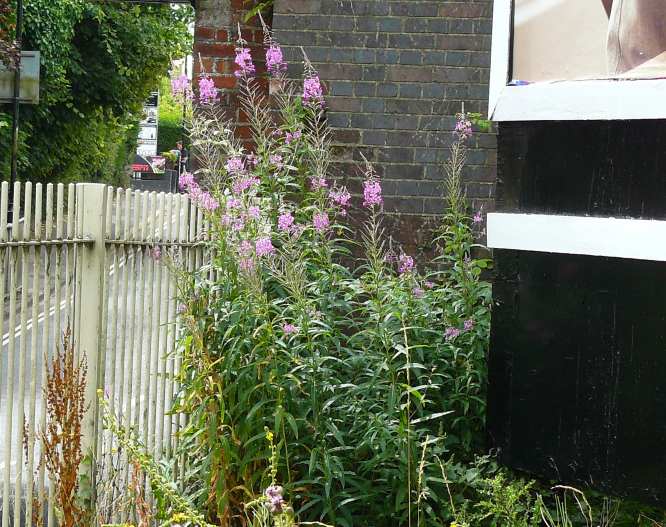
Environment
Maurice Lillie found
yet another Crack Willow tree was down across the
river near the south bridge. He has informed the
Council arborist Andrew Skeet who will no doubt deal
with it. However, it is not interfering with river
flow as there is almost none anyway.
THURSDAY
JULY 25 - 2013
BROOK
MEADOW
Sharp-flowered
Rush is flowering well on the Lumley area along
with Hard Rush and a nice crop of Square-stalked St
John's-wort. It is strange to think that
Sharp-flowered Rush was unknown on Brook Meadow until
2009 and now it is abundant on the Lumley area.
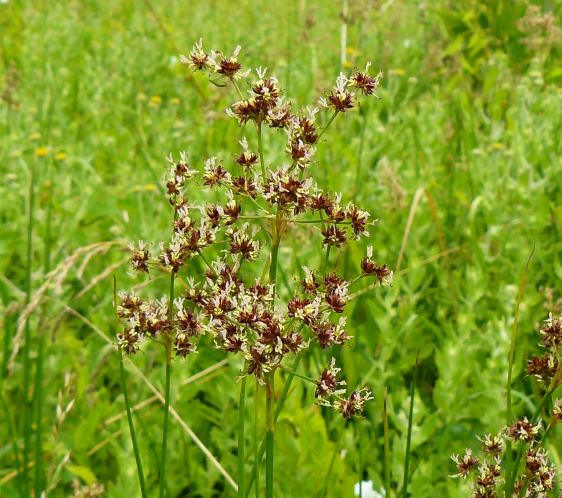
Mystery
willowherb
I took sample of the
mystery willowherb that I found on the river bank in
Palmer's Road Copse, along with a Great Willowherb
growing nearby, over to Ralph Hollins for his opinion.
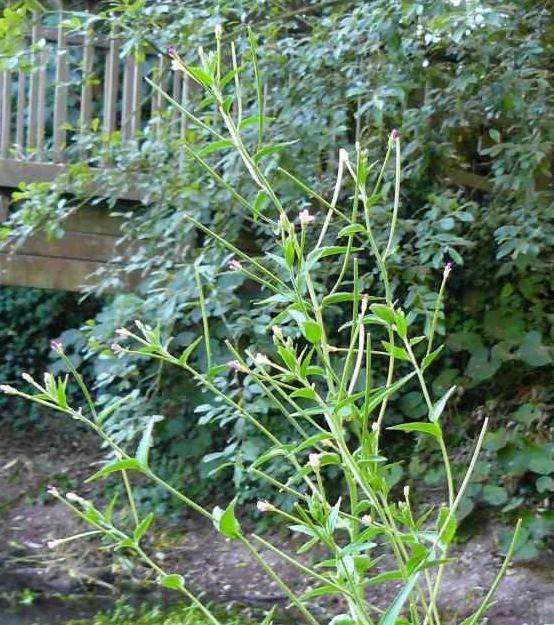
After much discussion
we decided that the mystery plant was definitely not a
straightforward Great Willowherb, but was probably a
hybrid between Great Willowherb, which grows
abundantly on Brook Meadow, and Hoary Willowherb. We
compared the upper part of the mystery plant with a
Hoary Willowherb that was growing in Ralph's front
garden and they were virtually identical, with small
flowers and long ridged pods, but the lower parts of
the plants were quite different. Kitchener's paper
does stress that "Virtually every combination of
crosses between the British Epilobium species is
known".
Small
butterflies
Ralph Hollins pointed
out that the very small Green-veined White in the
photo of a pair mating by Brian Lawrence on July 23 is
not surprising.

He says, "I have
always understood that when caterpillars do not get
the normal amount of food for their development they
can still pupate successfully and emerge as fully
working but small sized adults. I thought I would have
no difficulty in finding evidence to support this but
(while there were many accounts of scientific
investigations into the variation in the size of eggs
laid by butterflies of the same species) the only
reference to size variation in adults came in a
lengthy report at http://www.ukbutterflies.co.uk/reports_variation.php
in which I could only find one relevant paragraph
saying ..... 'If the caterpillar is under-nourished
for some reason (such as having insufficient food
plant in its environment) then an undersized adult
butterfly may result. However, the genetic composition
of the butterfly remains constant and is passed to any
offspring unchanged, just as the child of a
bodybuilder doesn't benefit from the workouts of their
parents!'"
MILLPOND
NEWS
No change on the local
millponds. The Mute Swan with her one remaining cygnet
was on Peter Pond. The family with 3 cygnets
(including the white one) was on Dolphin Lake. All
three Great Black-backed Gull chicks are still on
Slipper Millpond with one adult.
WEDNESDAY
JULY 24 - 2013
BROOK
MEADOW
Mystery
Willowherbs
I clambered through
the dense thicket of brambles and nettles onto the
east bank of the river in Palmer's Road Copse this
afternoon to have a closer look at the mystery
willowherbs that I saw from the south bridge
yesterday. I found about 10 of the mystery willowherbs
with small flowers growing on the edge of the river.
The tallest was about my height - ie around 140cm
which set alarm bells ringing immediately about my
initial identification of them as Marsh Willowherb, as
that grows to only 60cm. There were in fact some
definite Great Willowherbs nearby with larger flowers
and they were even taller. I picked samples of both to
study more closely at home.
Here
is the mystery willowherb with the south bridge in the
background

My fears were
confirmed when I looked at the flowers, which had
four-lobed stigmas. This definitely ruled out Marsh
Willowherb and pointed more clearly to Great
Willowherb or possibly Hoary Willowherb which does
have smaller flowers than Great Willowherb. However, I
am familiar with Hoary Willowherb on the waysides and
I can usually pick them out on the basis of their
general 'hoary' appearance. The ones on the river bank
did not look particularly hoary and were taller than
the usual limit for Hoary Willowherb. Also, against
the Hoary Willowherb identification was the fact that
the stigmas were not upright. Rose says the leaf bases
of Hoary Willowherb do not clasp or run down the stem
as in Great Willowherb and I thought could have been
the case with the mystery plants. However, my
conclusion after all this is that the mystery plants
are probably Great Willowherb, though a bit slimmer
than the usual ones and with smaller flowers.
Butterflies
I walked back through
the meadow where plenty of butterflies were on the
wing as usual, though not many came to rest. A very
nice Ringlet was an exception showing its
distinctive underwings on the Lumley area.
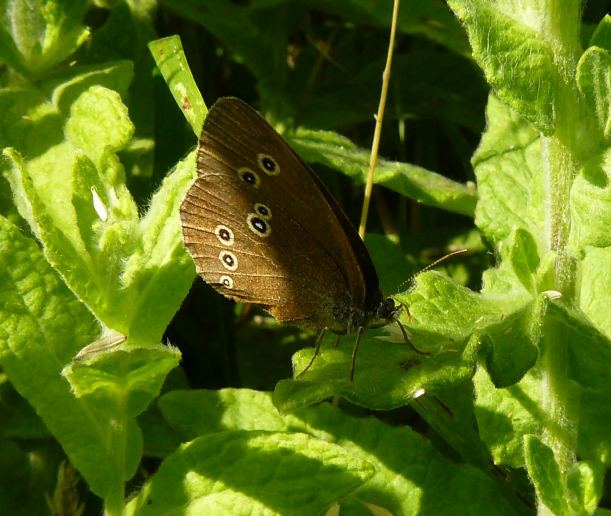
I also captured this
image of a pair of Gatekeepers mating. Like the
Green-veined Whites yesterday, these were flying
around still coupled together. Only the underwings are
showing in the photo.
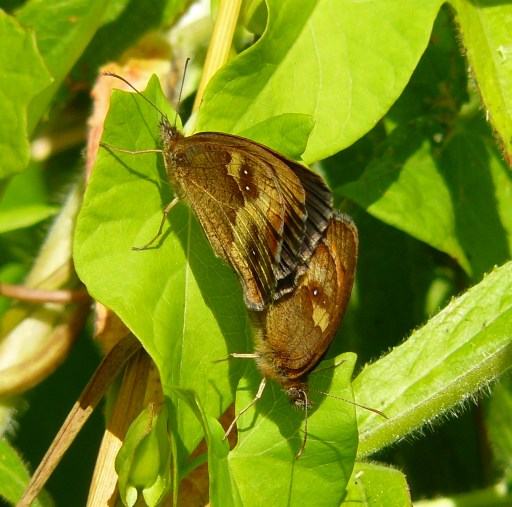
Other
insects
Malcolm Phillips got a
photo of an old friend that we see each summer on
Brook Meadow . There is no mistaking this very
distinctively marked Longhorn beetle (I hope) as
Strangalia maculata, here seen feeding
on a Hogweed flower head. This was out first sighting
of the year.

Malcolm
also got this damselfly which could be a female Banded
Demoiselle or Beautiful Demoiselle
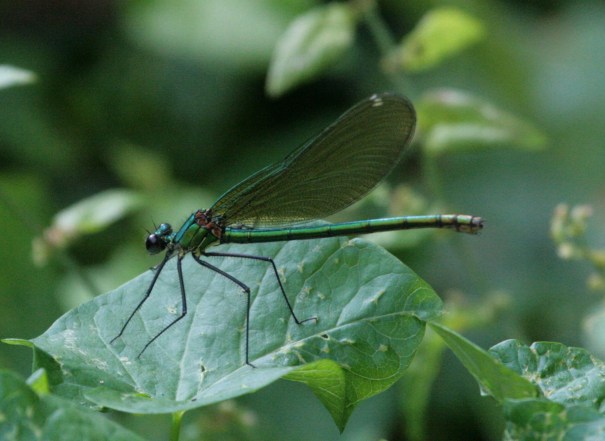
OTHER
NEWS
Swan
cygnets
Stephanie Bennett sent
me the following photo of three swan cygnets on
Langstone Mill Pond, looking strong and healthy -
taken by Jon Cox last weekend. Nice to hear some good
news on the cygnet front for a change!
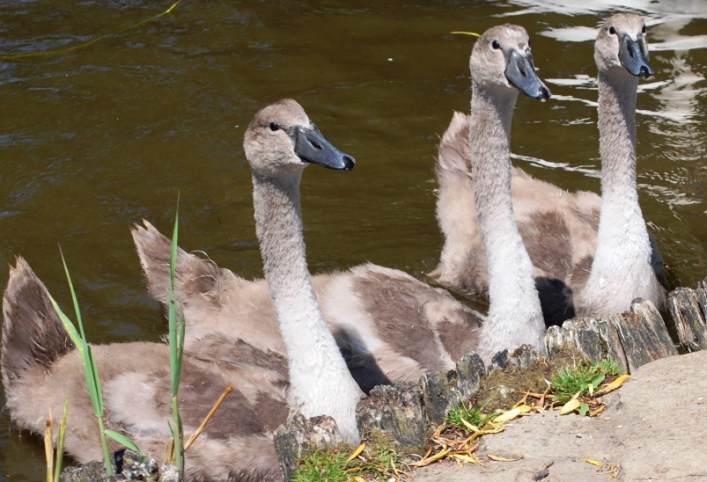
Blue-tailed
Damselfly in garden
After Red Damselflies
last month, Peter Milinets-Raby had his garden pond
taken over by four Blue-tailed Damselflies today. Here
is one of them. What a beauty.
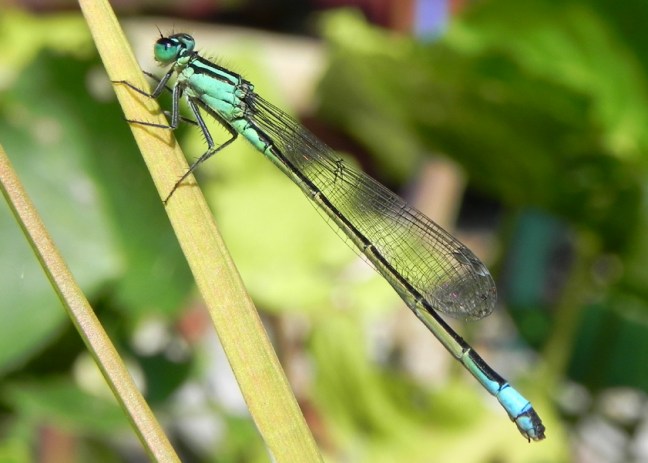
TUESDAY
JULY 23 - 2013
BROOK
MEADOW
Butterflies
I had a walk through
the meadow this morning. It was much cooler than
yesterday, but very humid. There were masses of
butterflies on the wing, including Meadow Brown,
Gatekeeper, Large Skipper, Small Skipper, Comma, Red
Admiral, Large White, Small White, Green-veined White
and a possible Marbled White.
Green-veined
Whites puzzle
Brian Lawrence got a
photo of an unusual coupling of two Green-veined White
butterflies on Brook Meadow today. He said they were
also flying while joined up too. I found Brian's photo
puzzling due to a big discrepancy in size between the
two insects. Brian assured me that one of them was
large and the other was small exactly as in the photo
which was taken almost head on. What the heck is going
on? Is it possible to have such variation in size of
butterflies?
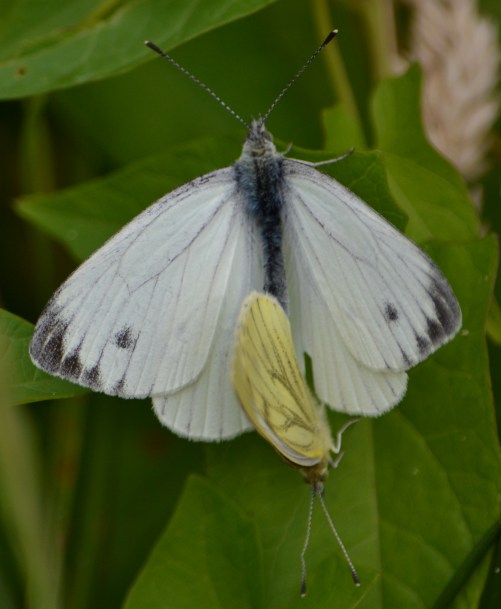
Wild
flowers
Newly flowering on the
meadow were Lesser Burdock, Common Fleabane (general),
Enchanter's Nightshade (outside the south gate) and
one spike of Purple Loosestrife on the east bank of
the river above the south bridge. There are some
splendid burs on the Branched Bur-reed right in front
of the observation fence. I also found a good tuft of
Giant
Fescue growing
and flowering at the base of the first Crack Willow
tree along the path through Palmer's Road Copse from
the south bridge.
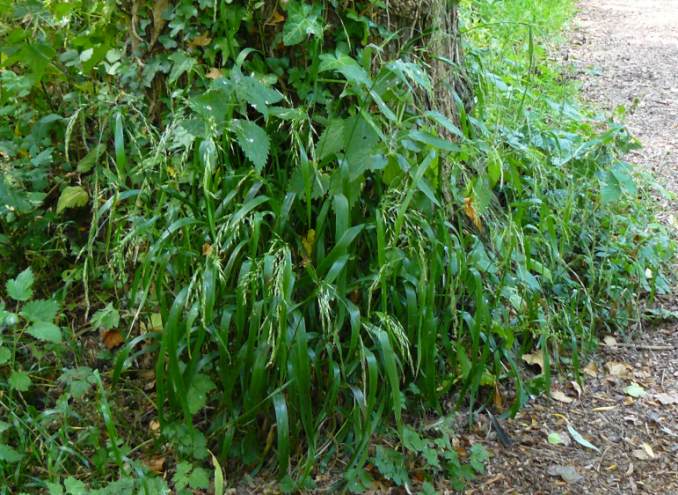
Mystery
willowherb
My attention was
attracted to a tall willowherb on the east bank near
the Purple Loosestrife which was quite different from
the Great Willowherb which was flowering nearby on the
west bank. I appreciate willowherbs are a very complex
group to identify, but I am inclined towards a
possible Marsh Willowherb, based mainly on its small
flowers, narrow lanceolate leaves and slender erect
stem. But I will need to get onto the east bank to
have a closer look at it.

Water
Vole
Malcolm Phillips was
also on Brook Meadow again today taking photos of
various birds and butterflies. No Purple Hairstreak
today, but Malcolm see a Buzzard soaring overhead and
got the following image of a Water Vole having a snack
beneath the south bridge at 12.30pm.

MILLPOND
NEWS
I was pleased to see
the Mute Swan family from the Peter Pond nest
with their one remaining cygnet back on Peter Pond and
away from the dangers lurking on the neighbouring
Slipper Millpond.
Interestingly, I could
only see two of the three Great Black-backed Gull
chicks on Slipper Millpond, which suggests that
they are now becoming more mobile and that one has
left the pond. However, on the basis of last year's
experience I expect it to return. One of the chicks
was on the north raft near the bridge and while I was
watching one of its parents arrived and literally
grabbed the youngster by the scruff of the neck and
flung it into the water. Clearly, the intention was to
get the young bird to get moving. The effect on the
chick was to send it scuttling over to the wall next
to the Chequers Quay buildings where it was still
cowering when I left.

Cormorants are
back on the centre raft now that the Great
Black-backed Gulls have vacated it; there were 6 there
this morning.
Meanwhile, over on the
town millpond I have to report the sad news that the
Coot nest on the north end of the pond has
succumbed to the rising waters and is no more.
OTHER
NEWS
House
Martins bred
Paul Cooper writes to
say that 'his' House Martins have successfully bred on
his house in Lynch Down, Funtington as have the ones
next door. He was rather worried a few weeks ago as
the adults disappeared but then they returned and
bred. There are two chicks which look as if they will
be ready to fly soon.
Stansted
butterflies
Paul also reports that
on Sunday his partner saw approx 50 Silver-washed
Fritillaries and he saw about a dozen yesterday in
Stansted Park at Rowlands Castle - just through the
entrance in the wall opposite The Castle pub and on
the tracks after there. She also saw on Sunday approx
40 White Admirals plus lots of Marbled Whites
and other more common butterflies on the grassland in
the Park.
MONDAY
JULY 22 - 2013
BROOK
MEADOW
Purple
Hairstreak
Malcolm Phillips has
had a couple of good days with his camera on the
meadow, getting an excellent selection of butterflies.
The best of all was this Purple Hairstreak which he
saw on Sunday morning (July 21) opposite the north
bridge on the east side of the north meadow just along
side the pathway. This was a first ever for Brook
Meadow. Malcolm's photo shows well the dark upperwing
with the distinctive purple blotch and the white
streak on the silver-grey underwing.
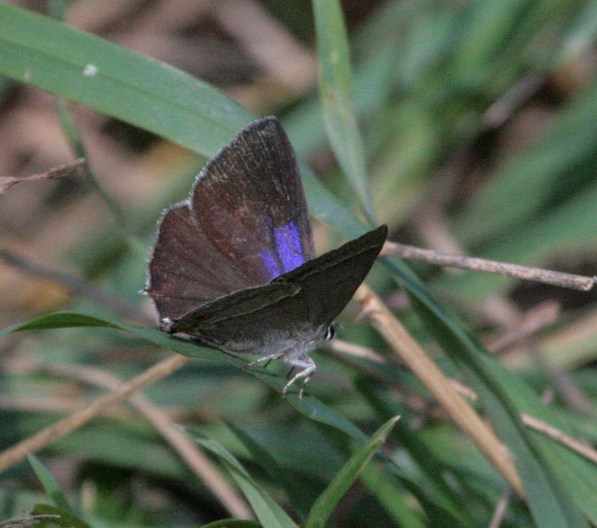
This second photo
below shows the white streak much better and the
single black-pupilled orange eye beside the tail.
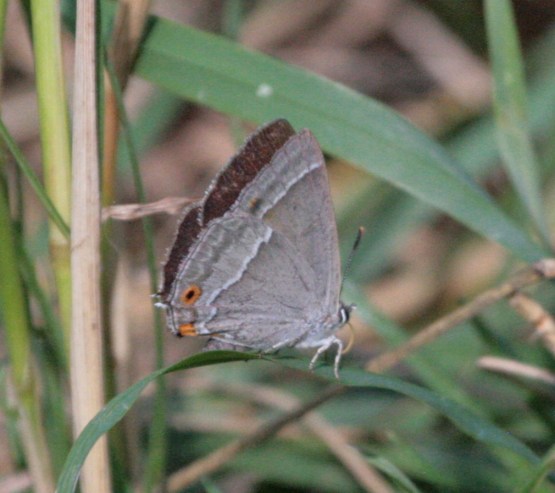
Purple Hairstreak is
mainly associated with Oak trees on which its larva
feeds. It may have been attracted by our our recent
plantings of five Oaks on the Seagull Lane patch to
add to those already present on Brook Meadow. The
adults feed mainly on honey-dew, obtained from Oaks
and Ash, though it may well have been making use of
the Crack Willows which abound on the meadow.
Apparently, in very hot weather, like we have been
experiencing recently, adults will descend to seek
moisture from the ground, which might account for the
one that Malcolm found. It looks as if this is a good
year for Purple Hairstreak as 17 were recorded in
Havant Thicket on July 21
Today, Malcolm also
had the first Marbled White of the year plus
Red Admiral and Gatekeeper which are now very
numerous.
Beautiful
Demoiselle
Today, Malcolm also
got the following image of what I am sure is the first
Beautiful Demoiselle (Calopteryx virgo) seen on
Brook Meadow this year. The photo shows a male with
the distinctive fully blue wings; it lacks the dark
band of the Banded Demoiselle, which is a far more
common damselfly on Brook Meadow. Malcolm also
photographed the last Beautiful Demoiselle on Brook
Meadow on June 2 last year.
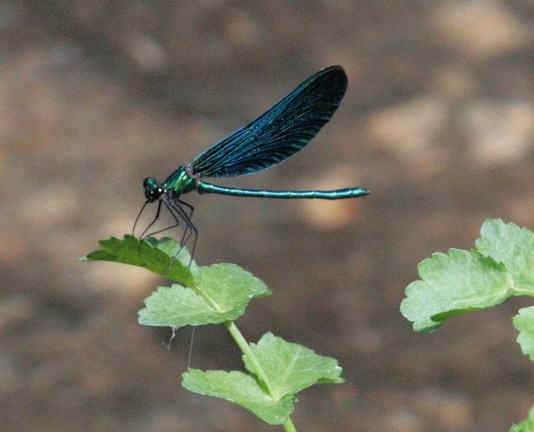
Water
Vole & Brown Trout
Malcolm had two river
sightings. One was a Water Vole in the river beneath
the south bridge. Most of our sightings are now coming
this area, which is hardly surprising as this is the
most easily viewed area of the river. This was
sighting number 107 for the year so far. Malcolm also
got this image of a Brown Trout with its very
distinctive spots. But what is that red spot near the
gills?
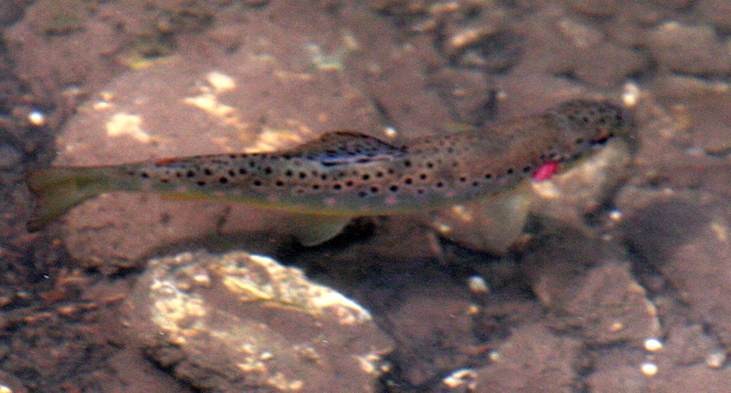
Strawberry
Clover
I found Strawberry
Clover to be flowering for the first time this year at
the start of cross path from the Lumley gate; some
plants already were showing the distinctive strawberry
fruits. This is a bit earlier than in the past few
years, which makes a nice change.
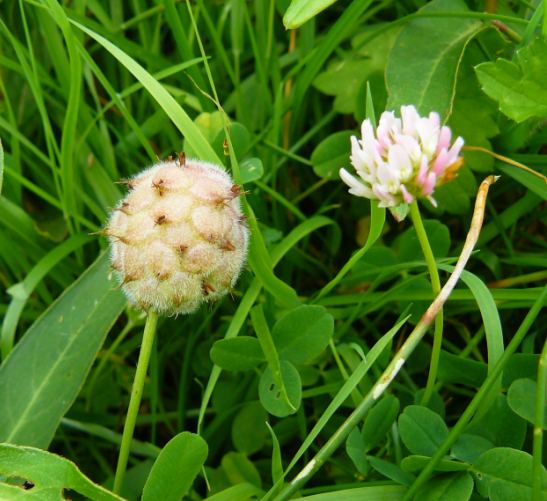
MILLPOND
NEWS
There was no change on
the millponds from the weekend with the Mute Swan
families both on the town millpond and on Peter Pond
with one cygnet each. However, the Coot on its
'tower nest' on Emsworth Millpond was having
severe problems today with the high spring tide
swamping its nest. Malcolm Phillips found it
desperately trying to build the nest higher to
preserve the three eggs, which it has sat on so
steadfastly through all the hot weather.
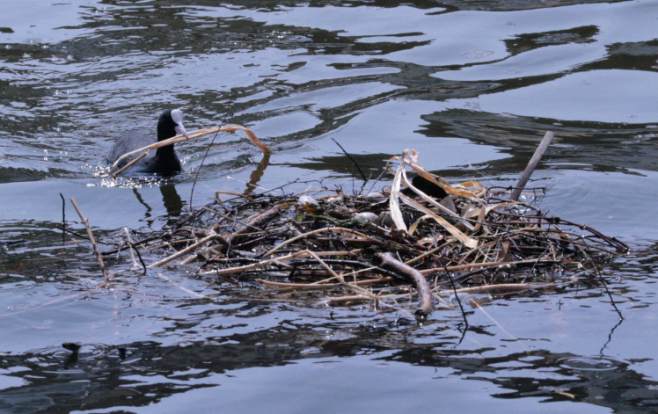
GARDEN
NEWS
Peter Milinets-Raby
had two unexpected new bird visitors to his Havant
garden today. Both were enticed in by the pond - the
urge to drink being very strong! The first was a
Stock Dove, which flew off before Peter could
get his camera out. These are fairly unusual garden
birds, though I have had a few sightings in my
Emsworth garden over the past year, the last being a
pair on May 30. The second was this magnificent
Rook which lingered on the fence as if wanting
to come back for some more water. Rook is ranked at 29
in the BTO garden bird list and is reported in about
9% of gardens at this time of the year. Personally, I
have never seen one in my garden.
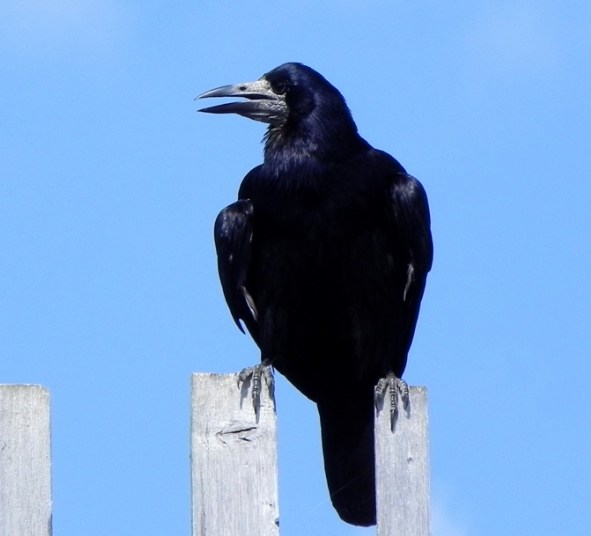
HAYLING
OYSTERBEDS - news update
Chris Cockburn
provided the following news up date from the
Oysterbeds:
"It's beginning to get
less crowded out on the two lagoon islands with the
departure of many black-headed gull families
(productivity seems to be heading for c1.65 young per
pair). Despite the lower bird numbers, noise levels
are still quite high especially when the black-headed
gulls are shouting at their squeaking youngsters as
they fly in and out of the lagoon.
The five Mediterranean
gull nesters will most likely have a final
productivity rate of 1 young per pair and it should
not be too many days before they leave.
Sandwich terns in
moult are now a regular sight; today there were 30+
and it is noteworthy that they are clustered around
the Mediterranean gulls on the easternmost curved
island. It is likely that the strong black hood/white
neck contrast attracts Sandwich terns to Med gulls
(and vice versa as often noted on South Binness Island
in previous years). It is also interesting that the
Sandwich terns started using the Oysterbeds on the day
after a sailboarder was seen enjoying a stroll along
the S Binness vegetated ridge in areas often favoured
by Sandwich terns.
It looks as if the
breeding season for common terns will continue for
many weeks. There are many youngsters able to fly,
there are chicks from newly hatched to almost three
weeks old and there is a significant number of adults
that are apparently on eggs. The main pattern seems to
be that the common terns have two eggs that hatch with
only one chick surviving more than a few days. The
surviving singletons all seem to be doing well so it
is likely that there is a food problem with only
enough prey items for one chick (but given the
lateness of the breeding attempts, another factor
might be that the terns have not reached the best
breeding condition)."
SUNDAY
JULY 21 - 2013
MILLPOND
NEWS
Cygnet
attacked
I had a phone call
last night from a resident of Slipper Road to say that
one of the two Mute Swan cygnets was badly injured
near Chequers Quay on Slipper Millpond. I also had an
e-mail from Brendan Gibb-Gray who lives in Chequers
Quay with the same news. He said local residents had
done what they could, but to no avail. Both thought
the cygnet had been attacked by one of the Great
Black-backed Gull chicks which had been in this area
during the day. This is no surprise as the chicks are
now large and fairly mobile birds and will be
developing their predatory instincts.
I had a look this
morning and found the Mute Swan pen with her one
remaining cygnet on Peter Pond. It looked fine as
shown in the photo.
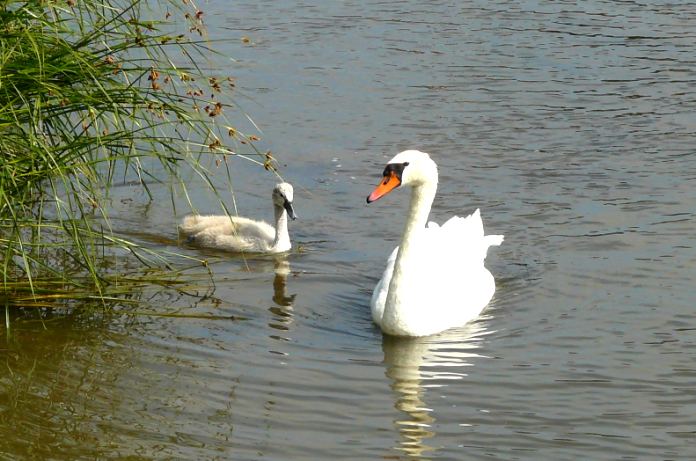
Later they were on
Slipper Millpond near the bridge where the Great
Black-backed Gulls and the chicks were present.
Definitely not a good idea! There was no sign of the
corpse of the other cygnet. Frankly, I cannot hold out
much hope for the remaining cygnet if the swans stay
on Slipper Millpond.
The three Great
Black-backed Gull chicks were near the north raft on
this photo with an adult

I shall be
recommending to the Slipper Millpond Association that
the centre raft where the gulls have nested for the
past two years is moved to the side of the pond so as
to deter them from nesting there next year. Although
they are magnificent birds their presence has
unbalanced the ecology of the pond to the extent that
no other birds have been able to nest successfully on
the pond, in particular Coots, Mallard and Mute Swans.
They are just too big for our small pond!
Other
news
Meanwhile, the cygnet
from the 'litter nest' on the town millpond seems to
be doing well. It's looking nice and fluffy and
growing stronger by the day. Juliet Walker took this
photo of mum and youngster taking their evening
ablutions.
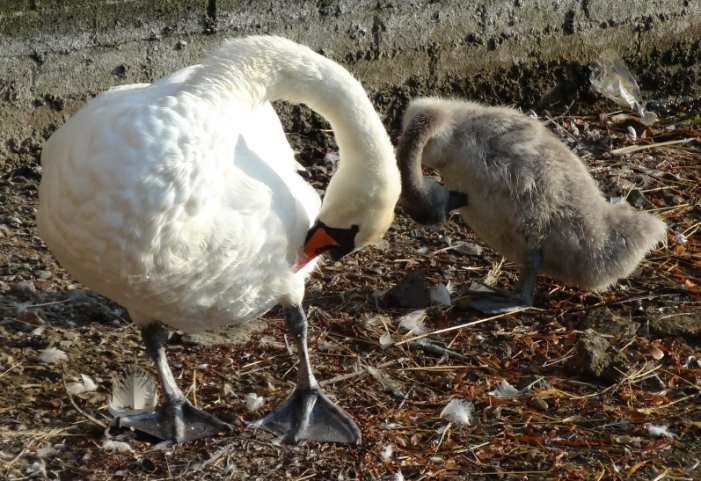
The Mute Swan family
with 3 cygnets (including the white one) that nested
on the marina embankment is still together and were on
the marina this morning.
The Coot is still on
its tower nest at the northern end of the town
millpond where it has been ensconced for the past 2
weeks or so. I think hatching should be any time now
and well deserved it will be too for surviving this
hot weather.
SATURDAY
JULY 20 - 2013
BURTON
MILL POND
Tony Wootton reported
on this morning's walk by the Havant Wildlife Group
and what a bonanza they had!
"Five went to Burton
Mill Pond on what was the first comparatively cool and
cloudy day for a about 2 weeks. Birds. Very few seen,
Jackdaw, Mute Swan, Great Crested Grebe, Mallard,
Coot, but heard was Chiffchaff, Wren, Great Spotted
Woodpecker , Green Woodpecker, Reed Warbler.
Butterflies, very few again, mainly whites, ringlets
and meadow browns, but the first Gatekeeper of the
year for most of us. Dragons and damsels. Only one
unidentified dragon in a warm boggy area. Lots of blue
damselflies, one of which was a blue-tailed plus a
banded demoiselle.
Plants, because of the
terrain, many different ones to normal. Bogbean,
sphagnum moss, yellow loosestrife, hemlock water
dropwort, alder buckthorn, greater willowherb, rosebay
willow herb, greater tussock sedge, skullcap, marsh
bed straw, common water plantain, Gipsywort,
honeysuckle, bulrush, crossleaf heather, wood sage,
musk mallow, lesser and greater burdock, hemp
Agrimony, hogweed, brandy bottle water lily, woody
nightshade, forget me not, Nipplewort, marsh thistle,
red campion, white water lily, arrowhead, Branched
Bur-reed, bristly ox-tongue, creeping thistle,
creeping cinquefoil, centaury, betony, enchanted
nightshade, Vervain, Selfheal, climbing corydalis.
Phew, thanks to Ros for 99.999% of the i.d. and to
Hilary for the note taking.
Here
is the Arrowhead named after its arrow-shaped leaves
which unfortunately are now shown in the photo
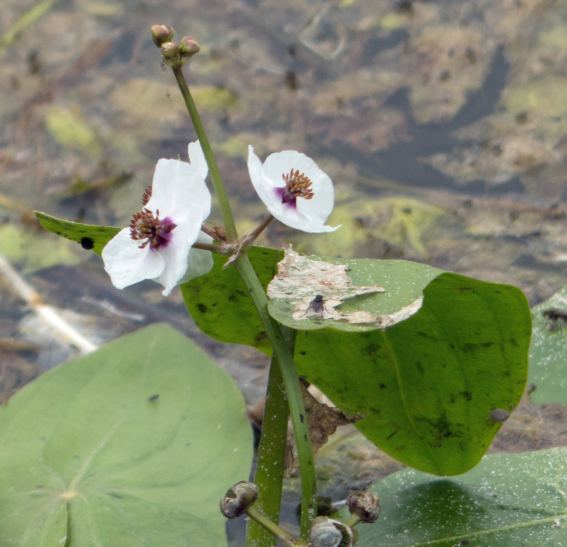
Here
are the stalwart naturalists beneath the oldest sweet
chestnut you ever did see
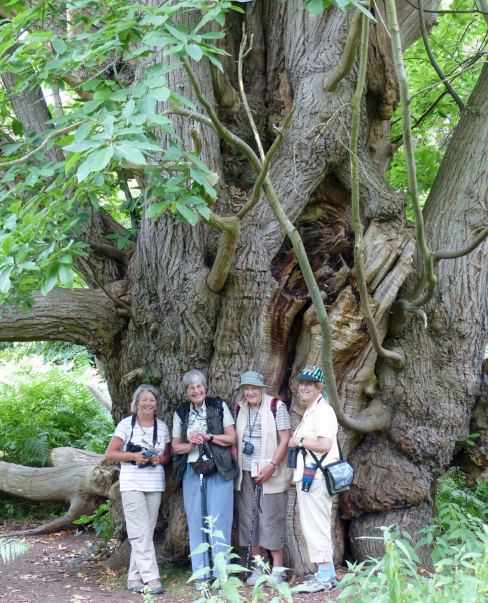
For more information
about the Havant Wildlife Group and reports of walks
go to . . . Havant
Wildlife Group
OTHER
NEWS
Swallow-tailed
Moth
Malcolm Phillips had
this moth come through the open window into the hall
of his flat in Emsworth today.
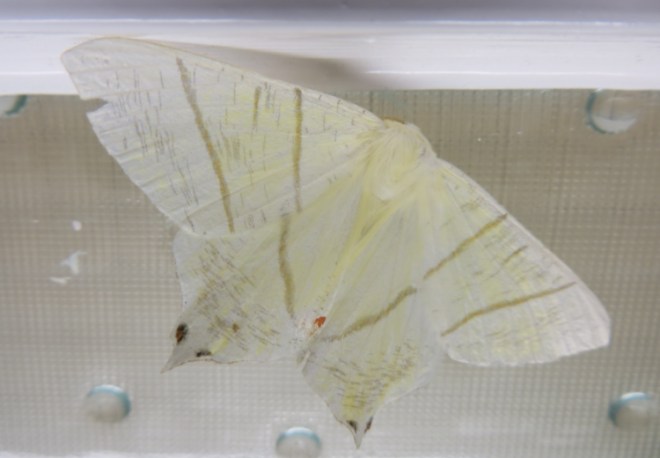
I usually approach
moth identification with some trepidation, but this
one I am fairly sure about having seen it myself a few
years ago (famous last words!). I think it is a
Swallow-tailed Moth (Ourapteryx sambucaria) which the
HantsMoths web site says is one of the largest and
most spectacular geometer moths and is common in
woodland, scrub, hedgerows, parks and gardens,
throughout the British Isles. See . . .
http://www.hantsmoths.org.uk/species/1922.php
Juvenile Dunnock - Correction
this is a young Starling
Graham Petrie had a
young bird on the bird table in his garden, which he
was not sure about. At first I thought it looked like
a juvenile Dunnock but I am now pretty sure that it
is, in fact, a young Starling. Graham sent me another
photo showing bill more clearly and stressing that the
size of the bird was much larger than a Dunnock. After
seeing Graham's photo Charlie Annalls added that she
had been getting young Starlings in her garden in
Portsmouth which looked just like Graham's.
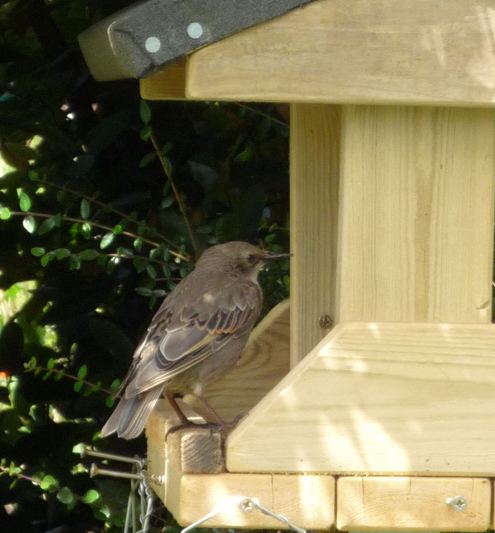
FRIDAY
JULY 19 - 2013
BROOK
MEADOW
The flowers of Hemp
Agrimony are starting to open on the orchid area.
I noticed the first red Blackberries on the
large bushes on the north path. There is a good
flowering of the Broad-leaved Everlasting-pea
despite the rampant growth of grasses and other
plants in this area. As Bob Chapman included a photo
of these flowers in his Farlington Marshes blog for
today http://solentreserves.wordpress.com/
that seemed good enough excuse for me to have one
here!
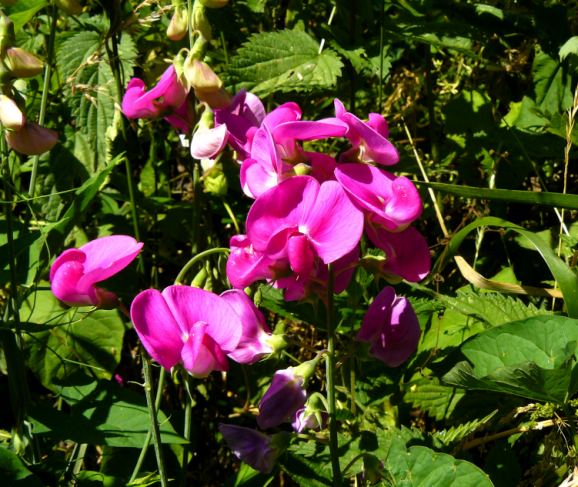
Martin Cull has
stacked the arisings from the annual cut in two
large piles on the east side of the north meadow, very
close to the Lumley Road gardens. I have warned the
conservation group of the need to check the piles
regularly for any signs of combustion. We don't want
the fire brigade in here again like happened a few
years ago.
SLIPPER
MILLPOND
Two of the Great
Black-backed Gull chicks were on the centre raft
in company with 6 Cormorants. The other chick was on
the north raft begging for food from a visiting adult.
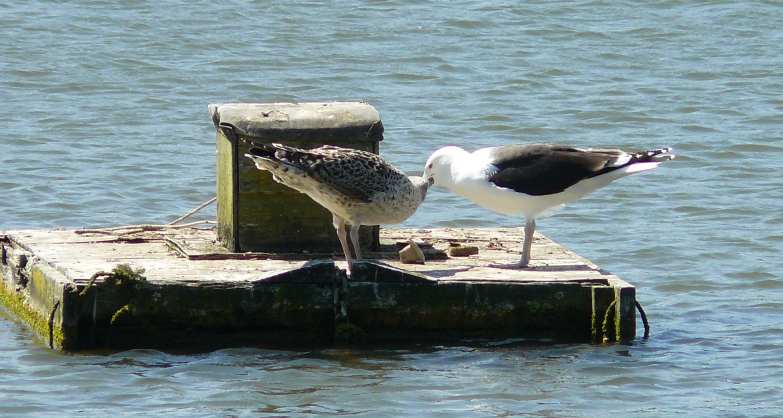
There was a large
gathering (shoals) of young Grey Mullett in the
shallow water by the Hermitage Bridge.
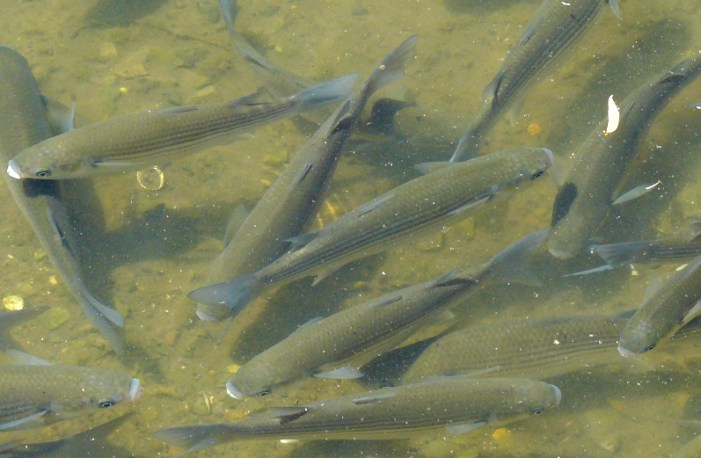
OTHER
NEWS
Kestrel
returns
Charlie Annalls had a
return visit from a male Kestrel to her garden in
Anchorage Park Portsmouth yesterday. She last saw what
was probably the same bird on July 6, but this time he
perched much higher up on the roof. He was scared off
by people in the area so Charlie only got a few shots
before he flew off in the direction of Hilsea Lines.
In this photo he seems to be saying, 'Hi, Charlie, I'm
back'.

Purple
Emperors
South Today this
evening had a piece about a team of butterfly experts
rushing around the countryside looking for Purple
Emperors. I don't think they found any. They could not
have gone to Southleigh Forest where John Bogle saw
another two males in the same spot as yesterday's and
possibly a third at another oak further along the
ride. Bob Chapman has a smashing photo of a Purple
Emperor on his Solent Reserves blog for today see . .
. http://solentreserves.wordpress.com/
THURSDAY
JULY 18 - 2013
BROOK
MEADOW
Conservation
work
I went over the meadow
this morning for the regular workday. There was a
remarkably good turn out of 15 volunteers considering
the very hot weather. They included two ladies from
the local Co-op store complete with emblazoned
T-shirts.
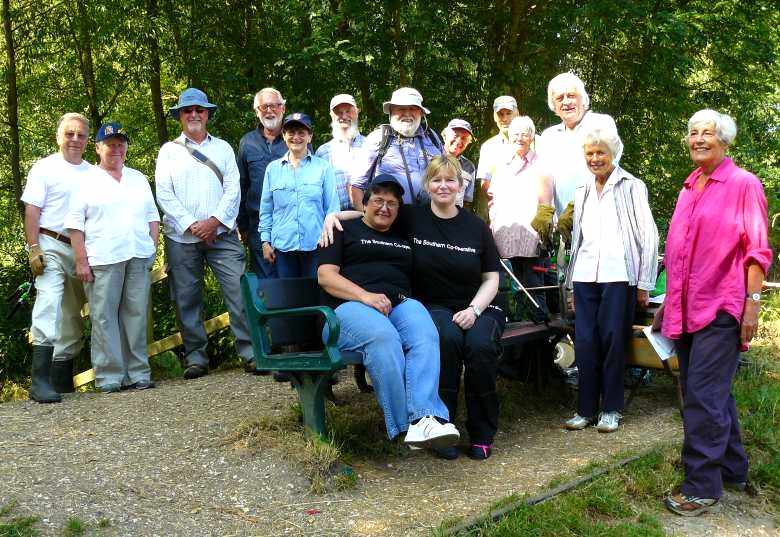
The main jobs were to
tidy up the paths in the south meadow and to clear
some fallen trees. But everyone was pleased when the
coffee break arrived supplemented with ripe
strawberries from Pam Phillips's allotment - they were
delicious.
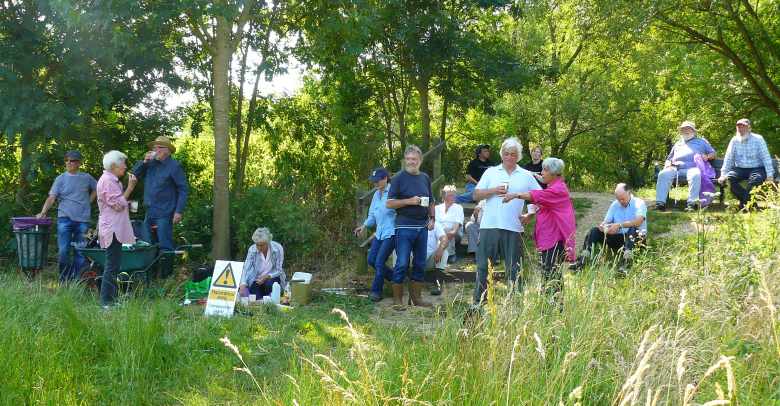
Annual
cut
It was very good to
see Martin Cull with his tractor back on the meadow to
carry out the annual cut. Martin, and his father Brian
before him, used to do the cut in the early years of
the meadow and always did a splendid job.
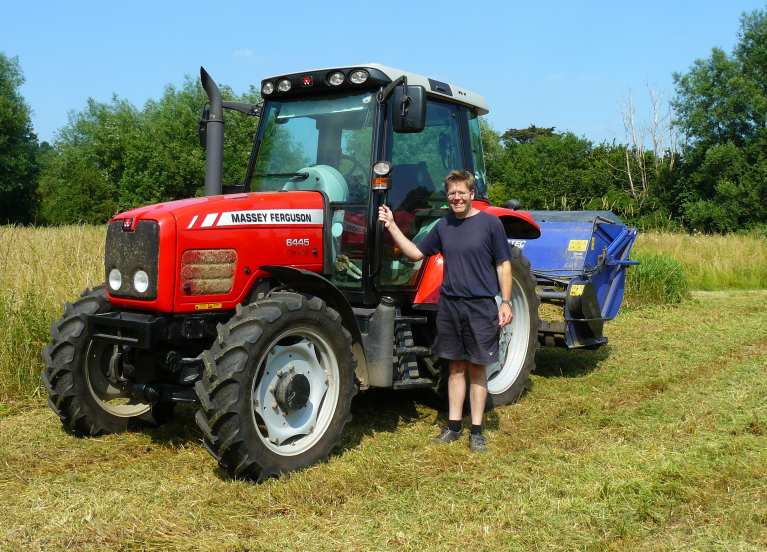
On this occasion,
Martin is here for just one day and will be cutting
the main areas of coarse grassland, including parts of
the centre meadow and the north meadow. However, we
hope to get him back to do the rest, including the
Lumley area and the orchid area, in the autumn after
the wild flowers have set seed. Here is Martin in
action on the north meadow.

Wildlife
Plenty of butterflies
were on the wing around the meadow, including Meadow
Brown, Gatekeeper, Large and Small Skippers and a
single Comma near the seat.
Marsh Woundwort
has just started to flower on Brook Meadow for the
first time this year. It was in the usual spot,
forcing its way through a jungle of other plants in
front of the Horse Chestnut saplings at the north end
of the Bramble path. It is usually a late flowerer,
though those on the new Railway Wayside have been out
for a couple of weeks.

OTHER
NEWS
Swifts
Sitting in our back
garden on these very hot afternoons, my wife and I
have been regularly entertained by small parties
Swifts swooping around the houses. It is good to see
them, but numbers are well down on what they were
several years ago when we regularly had up to 30.
Today I would estimate the maximum was 15 with 8 being
a more regular number.
I was interested to
see the occasional Swift fly up to investigate the
hole beneath the eaves in my next door neighbour's
roof. It was probably a juvenile attracted by a
possible nesting site for next year, but Swifts have
not actually nested there for many years. This is
where Bumblebees nested earlier this summer, but they
have gone now.
Swallows
Brian Lawrence spotted
three young Swallows perched on the overhead wires in
Lumley Road by Peter Pond. Here is his photo of two of
them. Young Swallows are duller than adults with
patchy breast band. Their forked tails lack the long
streamers of the adults.

Peter Milinets-Raby
also had a family group of two adults and five
juvenile Swallows around his house in Havant all day,
which was very unusual.
Purple
Emperor
John Bogle got this
photo from yesterday of a Purple Emperor at the top of
an Oak tree in Southleigh Forest. John caught a brief
glimpse of possibly a second at another spot yesterday
too but he needs to spend a bit more time to get a
better look and be sure it's wasn't just a Silver
Washed Fritillary. He also saw quite a lot of Purple
Hairstreaks sparring at the top of the oaks too while
looking for Emperors. He now needs to work off the
crick in his neck from spending significant amounts of
time staring at the top of oak trees for the past few
days!
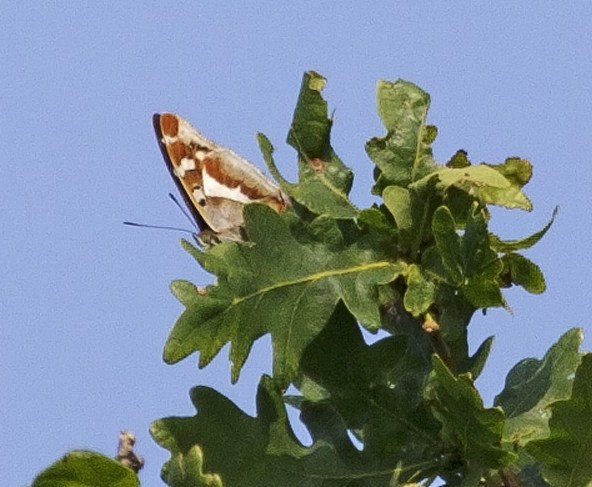
Both sexes of this
butterfly look alike except in sunshine when the
male's upper wings turn an iridescent purple. At all
other times the basic colour of both sexes is dusky
with a solid white band across the hindwings and a
patch of white on the forewings. The female is
recognisable by slightly more-rounded wingtips, and
the width of the white band on the hindwing. After
mating females go off in search of suitable Willows to
lay eggs, sometimes flying considerable distances. The
caterpillar feeds on the leaves of Goat and Grey
Willows and over winters in this stage.
The last local Purple
Emperor sighting I had reported to me was on 4 Aug
last year when Andy and Jane Brook saw a female in
Kings Road, Emsworth. Before that Alan Bonner had one
on his wheelie bin in Southbourne on 23 July
2010.
WEDNESDAY
JULY 17 - 2013
Emerald
Moth
Tony Wootton found
this moth in his hall this morning, unfortunately not
looking at all well.

It is clearly an
Emerald Moth, but which one, Common, Small or Small
Grass? Tony preferred Small Grass, though that one is
quite rare in Hampshire, except for the New Forest. I
would go for Common Emerald (Hemithea aestivaria),
though I am not a moth expert by any stretch of the
imagination! It is common in Hampshire and Tony's
photo matches well the one on the Hants Moths web site
. . . http://www.hantsmoths.org.uk/species/1669.php
Hants Moths describe
it as . . . "Common in woodland, hedgerows, scrubby
heathland, downland, gardens and parks throughout much
of lowland England and Wales; widespread and often
fairly common throughout Hampshire and on the Isle of
Wight. Wingspan 29-34 mm. Unmistakable. Larva
polyphagous on the foliage of many deciduous trees and
shrubs, including Hawthorn, Blackthorn and
Hazel."
Little
Egrets at Langstone
Ralph Hollins was at
Langstone Mill Pond last evening a good half hour
before sunset until twenty minutes after sunset and
counted at least 67 Egrets entering the roost for the
night.
See . . .
http://ralph-hollins.net/Diary.htm
For
earlier observations go to . . . July
1-15